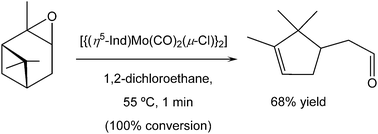Application of an indenyl molybdenum dicarbonyl complex in the isomerisation of α-pinene oxide to campholenic aldehyde†
Abstract
The complex [{(η5-Ind)Mo(CO)2(μ-Cl)}2] (1) has been tested for the industrially relevant catalytic isomerisation of α-pinene oxide (PinOx) to campholenic aldehyde (CPA) in the liquid phase. PinOx conversion and CPA selectivity are strongly influenced by the solvent employed. Complete conversion of PinOx was achieved within 1 min at 55 °C or 30 min at 35 °C using 1,2-dichloroethane as solvent, giving CPA in 68% yield. Other products included trans-carveol, iso-pinocamphone and trans-pinocarveol. The stability of 1 under the reaction conditions used was investigated by using FT-IR spectroscopy and electrospray ionisation mass spectrometry (ESI-MS) to characterise recovered solids. In the presence of air/moisture 1 undergoes oxidative decarbonylation upon dissolution to give oxomolybdenum species that are proposed to include a tetranuclear oxomolybdenum(V) complex. Conversely, ESI-MS studies of 1 dissolved in dry acetonitrile show mononuclear species of the type [IndMo(CO)2(CH3CN)n]+. The crystal structure of the ring-slipped dicarbonyl complex [(η3-Ind)Mo(CO)2Cl(CH3CN)2] (2) (obtained after dissolution of 1 in acetonitrile) is reported.


 Please wait while we load your content...
Please wait while we load your content...